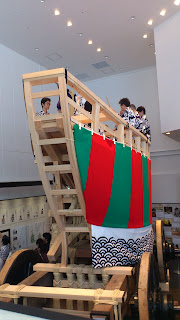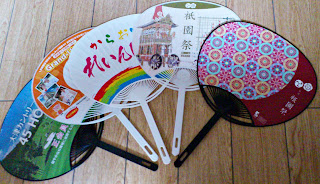Hailed as one of Japan's greatest festivals, the Gion Matsuri is a month-long festival in July, with the festival highlights being the Yoiyama from 14 to 16 July and the Yama Hoko Junko Grand Parade on 17 July.
 |
A ritual at Yasaka Shrine on 17 July 2012, just before the parade of the mikoshi
(portable shrine) that evening.
|
Just days away from the term exams, my school mates and I took time to bask in the lively atmosphere of Yoiyama, the "pre-party" to the Grand Parade. During Yoiyama, the downtown streets around Shijo and Karasuma were car-free. Food and game stalls were set up along the streets where the Yama and Hoko floats were on display. Throngs of people crowded into the streets in traditional yukata in the evenings, and the Gion Bayashi (the festival music) filled your ears.
A day before the exam, more than half the class did not turn up at school. They were watching the Grand Parade of massive Yama and Hoko floats. A classmate told me that truancy was necessary because watching the parade was a once-in-a-lifetime experience.
While I missed some of the most exciting parts of the festival, I managed to see enough to draw a few learning points and I thought I should share them here.
While I missed some of the most exciting parts of the festival, I managed to see enough to draw a few learning points and I thought I should share them here.
Yoiyama
Check out the floats but don't forget the traditional performances!
 |
One of the massive Hoko floats on display.
|
There were also traditional dance, music and theatrical performances held at the Yasaka Shrine (free entry) so one should try to drop by Yasaka Shrine to catch these performances. I didn't manage to watch these performances unfortunately, due to poor time management.
Soak in the evening atmosphere
I went to check out the Yoiyama in the afternoon trying to avoid the crowd. But on hindsight, I should have stayed till the evening to see the lit-up lanterns on the floats and on the streets in spite of the crowd. It was quite a sight, judging from the photos I saw from friends' albums.
Look out for treasures on display while walking through the streets
During Yoiyama, the old textile merchant homes and businesses on Shinmachi and Muromachi typically open up the front of their homes and shops to show off their antique folding screens and other treasures, a tradition from the ancient times. I actually overlooked all these treasures!
Buy a yukata (remember to compare prices!) and wear it
 |
Following the Hanagasa Flower Hat Procession on 24 July 2012. A parade that
was part of the Gion Matsuri.
|
Forget Uniqlo which does not carry a yukata collection every year, and Rakuten which sells yukata sets with pre-set obi (the piece of cloth you tie around the waist).
Stroll the streets and look out for shops selling traditional yukata, obi and other accessories at great prices. Many shops lowered the prices because of the matsuri. Besides, it was the summer sale period too.
 |
My yukaka cost 1800 Yen, my obi cost 800 Yen and
the pair of geta (free size) cost 800 Yen. It is possible
to find yukata at 1000 Yen and geta at 500 Yen
during this period.
|
I bought a yukata for a good price - at 3400 Yen (SGD 54) for a three-item set. It was the first shop I came across and I recalled it was in Shinmachi. But there were yukata sets with even better prices as I walked further on.
Note the time of the last bus
I had friends who were so absorbed in their revelry that they missed the last bus and had to take a taxi home. It seemed that Kyoto did not extend the bus service hours even when there was a massive event such as this. Generally, many buses stopped running at around 11pm.
The Parades
Go early to get a good photo position
 |
Having been to a few massive events here, I have learnt that
being a few hours early before an event to get a good
spot is very common among the Japanese.
|
I did not get to see the Grand Parade in the morning of 17 July but I witnessed the Shinko Festival that evening, after class. It was a ritual in which three mikoshi (portable shrine) carrying the shrine deities that presided over the matsuri were transported from Yasaka Shrine.
The ritual began at 6pm and I was there an hour earlier but the streets were already lined with people waiting. I had a position which was alright but decided to cross over to the side of the Yasaka Shrine. It turned out to be a mistake as the mikoshi did not exit from the main gate of the shrine. It might have been better to stay in the streets opposite the shrine.
I also noticed there were many people on the roof-top of a building overlooking the road intersection so I figured that should be a prime position too.
I learnt my lesson after the Shinko Festival and managed to get a good photo position early for the Hanagasa Flower Hat Procession on 24 July, which was a parade of large umbrella floats.
Never stand near a police officer
 |
| The Hanagasa Flower Hat Procession on 24 July 2012 in clear view. |
Never stand near a police officer
 |
Many of my photos had these men in blue in them.
|
Just as tourists and locals lined the streets to watch the parades, so did the the police officers. Many officers lined the streets yelling polite warnings at people and managing crowd movements. If you ended up at a spot near one, you would be beset with the most terrible misfortune of having these men in blue in every possible photo that you took of the parade. I think they look most out of place in the photos of a thousand-year-old festival!
Reflect on the festival
When my landlord spoke of the matsuri, he spoke about it with pride. And I felt the passion of the residents of Kyoto from what I saw of the matsuri. How could a city retain the traditions from days long past if not for the passion and conviction of its people?
I came across the story of the Ofune-hoko float which used to be part of the Grand Parade in the ancient days. But as it had been destroyed a few times in the past, it had been excluded from the Grand Parade for more than 100 years.
The locals who have been taking care of this float have been trying to reconstruct it to its past glory. For 15 years, they worked hard on reviving the float. The good news is there is a possibility of seeing this float back in action in 2014.
When I reflect on the festival, from the music that I heard, to the craftsmanship of the floats that I saw and the people who made it happen every year, I could not help but feel glad that I was there.
How could the Gion Matsuri be a once-in-a-lifetime experience? I have never thought that my ties with Kyoto would only last a summer.
 |
The skeleton of the Ofune-hoko float which was on display
at the Kyoto City Intangible Cultural Property Display Room
on the first floor of Yodobashi Camera in front of Kyoto Station.
|
When my landlord spoke of the matsuri, he spoke about it with pride. And I felt the passion of the residents of Kyoto from what I saw of the matsuri. How could a city retain the traditions from days long past if not for the passion and conviction of its people?
I came across the story of the Ofune-hoko float which used to be part of the Grand Parade in the ancient days. But as it had been destroyed a few times in the past, it had been excluded from the Grand Parade for more than 100 years.
The locals who have been taking care of this float have been trying to reconstruct it to its past glory. For 15 years, they worked hard on reviving the float. The good news is there is a possibility of seeing this float back in action in 2014.
 |
| I really like how the young people and children are always involved in the festivals. |
When I reflect on the festival, from the music that I heard, to the craftsmanship of the floats that I saw and the people who made it happen every year, I could not help but feel glad that I was there.
How could the Gion Matsuri be a once-in-a-lifetime experience? I have never thought that my ties with Kyoto would only last a summer.

























